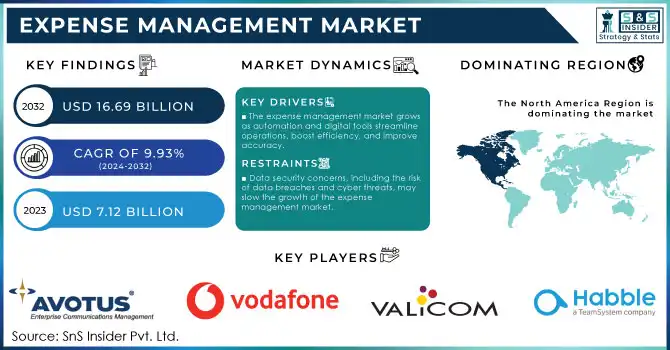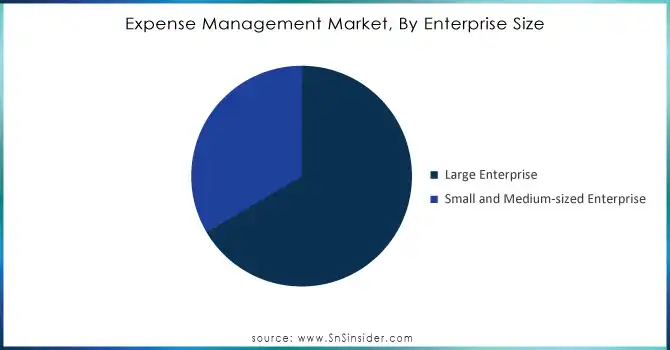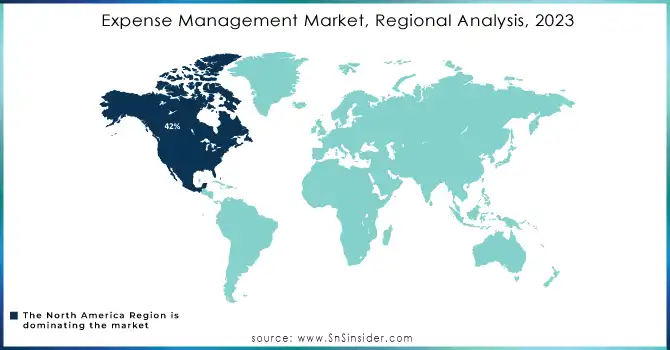Expense Management Market Report Scope & Overview:

Get more information on Expense Management Market - Request Sample Report
The Expense Management Market size was valued at USD 7.12 billion in 2023 and is expected to grow to USD 16.69 billion by 2032 and grow at a CAGR of 9.93% over the forecast period of 2024-2032.
The Expense Management Market is gaining significant momentum as businesses and individuals strive for more effective control over their financial operations. This market involves the use of software and platforms designed to streamline and automate the process of tracking, reporting, and managing expenses. Organizations, especially those in finance, retail, and corporate sectors, are increasingly adopting expense management solutions to enhance accuracy, improve efficiency, and ensure compliance with financial regulations.
One of the key growth drivers in this market is the increasing demand for automation and digitalization in financial operations. Traditional methods of managing expenses, such as spreadsheets and manual reports, are being replaced by cloud-based and AI-powered software that offer real-time expense tracking, data analytics, and integration with other financial systems. This shift helps reduce administrative workload and mitigates human errors, leading to better financial insights and faster decision-making. In terms of trends, mobile and cloud-based expense management solutions are becoming increasingly popular. Mobile apps enable employees to easily capture receipts and submit claims, providing convenience and improving efficiency. Additionally, cloud technology allows for seamless integration with other business systems, providing businesses with a unified view of their finances. Another trend is the growing use of artificial intelligence (AI) and machine learning (ML) to predict spending patterns, detect anomalies, and offer recommendations for cost-saving measures.
Expense Management Market Dynamics
DRIVERS
-
The growth of the expense management market is driven by the increasing adoption of automation and digital tools, which streamline operations, improve efficiency, and enhance accuracy.
The growth of the Expense Management Market is significantly driven by the ongoing trends of automation and digital transformation. As businesses increasingly embrace automation and digital tools to optimize operations, the demand for expense management solutions has surged. Automation plays a crucial role in eliminating time-consuming manual processes, reducing human error, and improving overall efficiency. By automating tasks such as data entry, approval workflows, and report generation, businesses can streamline their expense management processes, enabling faster and more accurate financial decision-making. Furthermore, digital tools provide real-time insights into spending patterns, allowing organizations to track expenses more effectively and identify cost-saving opportunities. This enhanced visibility into financial operations also empowers businesses to enforce compliance, monitor budgets, and manage reimbursements efficiently. The growing adoption of cloud-based solutions further accelerates this shift, as companies can now access expense management platforms remotely, enhancing flexibility and scalability. Cloud solutions reduce the need for on-premise infrastructure and enable seamless integration with other enterprise systems, such as ERP and HR platforms. These factors collectively contribute to the growth of the expense management market, as organizations recognize the value of automation in reducing operational costs, improving employee productivity, and ensuring better financial control.
RESTRAIN
-
Data security concerns, including the risk of data breaches and cyber threats, may slow the growth of the expense management market.
Data security concerns are a significant challenge to the growth of the expense management market, especially as businesses increasingly rely on digital and cloud-based solutions. Expense management systems handle sensitive financial information such as employee reimbursements, travel expenses, and corporate spending data, making them prime targets for cyberattacks and data breaches. The potential for unauthorized access to financial records, identity theft, or fraud creates a pressing need for robust security measures in these systems. As companies adopt cloud-based or third-party expense management platforms, the risks associated with sharing sensitive data over the internet or storing it off-site become more pronounced.
The fear of data breaches and the regulatory repercussions tied to non-compliance with data protection laws, such as GDPR or CCPA, make businesses hesitant to embrace these systems fully. Additionally, smaller organizations may lack the resources to implement the necessary cybersecurity protocols, making them more vulnerable to potential threats. This hesitation can slow the adoption of expense management solutions, particularly in industries where security is a top priority, such as finance, healthcare, and government. Despite these concerns, the expense management market continues to grow as vendors enhance the security features of their platforms. Advanced encryption, multi-factor authentication, and compliance with industry standards are becoming more common, helping to mitigate the risks associated with data security.
Expense Management Market Segment Analysis
By Type
The Telecom/Mobile Expense Management segment dominated with the market share over 42% in 2023, primarily due to the widespread adoption of mobile and telecom services across various industries. Businesses are increasingly relying on telecom services for communication, data transfer, and operational needs, making it crucial to manage these expenses effectively. Telecom/Mobile Expense Management solutions provide organizations with the tools to track usage, optimize plans, and control costs associated with mobile communications. This helps prevent wastage, identify inefficiencies, and ensure that businesses are only paying for what they need. For organizations managing large-scale telecom operations, such as global enterprises with numerous mobile devices and telecom contracts, these solutions are essential in reducing unnecessary expenditures.
By Enterprise Size
The Large Enterprises segment dominated with the market share over 62% in 2023, due to the complexity and scale of their financial operations. These organizations often have vast teams, multiple departments, and a high volume of transactions, all of which require advanced and scalable solutions to efficiently manage expenses. The intricate financial workflows, such as managing various budgets, approving expenditures, and generating detailed financial reports, necessitate sophisticated tools that can automate and streamline these processes. Furthermore, large enterprises often operate across multiple regions or countries, requiring expense management systems that can handle diverse currency, tax, and compliance requirements.

Need any customization research on Expense Management Market - Enquiry Now
Expense Management Market Regional Overview
North America region dominated with the market share over 42% in 2023, due to its advanced technological infrastructure, high digital adoption, and a robust economy. The region is home to several key players in the expense management software industry, such as SAP Concur, Expensify, and Zoho, which provide cutting-edge solutions for businesses across various sectors. The healthcare, retail, and manufacturing industries in North America have seen a rising need for streamlined financial processes, driving demand for automated expense management systems that reduce human error, improve accuracy, and enhance operational efficiency. Furthermore, companies in the region prioritize financial transparency and compliance, which expense management solutions can effectively support.
Asia-Pacific is the fastest-growing region in the expense management market, driven by rapid digital transformation across countries like India, China, and Japan. Significant investments in automation and cloud-based solutions are accelerating the adoption of advanced technologies. Additionally, the increasing number of small and medium enterprises (SMEs) in the region is fueling demand for expense management systems, as these businesses seek to streamline their financial processes, reduce costs, and enhance efficiency.

Some of the major key players of Expense Management Market
-
Avotus (Expense management software, Telecom expense management)
-
Vodafone Group Plc (Business expense management solutions, Telecom services)
-
Valicom (Telecom expense management, Voice and data billing solutions)
-
Habble Srl (Telecom expense management, Cost optimization tools)
-
VoicePlus (Telecom expense management, Automated expense tracking solutions)
-
Tangoe (Enterprise expense management software, Telecom expense management)
-
Calero-MDSL (Expense management software, Telecom and technology expense management)
-
Cass Information Systems, Inc. (Enterprise expense management, Telecom billing services)
-
Tellennium (Telecom expense management, Bill auditing and optimization services)
-
Brightfin (Expense management software, Telecom and cloud cost management)
-
SAP Concur (Travel and expense management solutions)
-
Coupa Software (Expense management, Spend management software)
-
Expensify (Expense reporting and management software)
-
Xpenditure (Expense management, Mobile expense tracking solutions)
-
Rydoo (Expense management, Corporate travel and expense solution)
-
Zoho Expense (Expense tracking, Budgeting and reporting software)
-
Certify (Expense management, Corporate travel and expenses automation)
-
Chrome River Technologies (Expense management, Invoice automation solutions)
-
Abacus (Real-time expense reporting, Corporate expense management software)
-
Emburse (Expense management, Corporate card and travel management solutions)
Suppliers for primarily known for personal finance management, Mint offers budgeting and tracking tools that can also be used for small business expenses of Expense Management Market
-
SAP Concur
-
Expensify
-
Certify (WEX)
-
Zoho Expense
-
Rydoo
-
Chrome River (Emburse)
-
SutiExpense
-
Divvy
-
Abacus (Bill.com)
-
Mint (Intuit)
RECENT DEVELOPMENT
-
In January 2024: Tangoe launched the Tangoe One Cloud solution, a hybrid cloud expense management platform that integrates Tangoe's public cloud control and visibility capabilities with VMware's private cloud services. This innovative platform allows businesses to monitor and allocate costs for both their public and private cloud infrastructures simultaneously.
| Report Attributes | Details |
|---|---|
| Market Size in 2023 | USD 7.12 billion |
| Market Size by 2032 | USD 16.69 billion |
| CAGR | CAGR of 9.96% From 2024 to 2032 |
| Base Year | 2023 |
| Forecast Period | 2024-2032 |
| Historical Data | 2020-2022 |
| Report Scope & Coverage | Market Size, Segments Analysis, Competitive Landscape, Regional Analysis, DROC & SWOT Analysis, Forecast Outlook |
| Key Segments | • By Type (Telecom/Mobile Expense Management, Cloud Expense Management (SaaS/UCaaS, IaaS, PaaS) • By Function (Dispute Management, Invoice and Contract Management, Ordering and Provisioning Management, Sourcing Management, Inventory Management, Usage Management, Others (Reporting) • By Enterprise Size (Large Enterprise, Small and Medium-sized Enterprise) • By End-use Industry (BFSI, Consumer Goods & Retail, Manufacturing, IT & Telecom, Healthcare, Media and Entertainment, Others (Transportation and Logistics) |
| Regional Analysis/Coverage | North America (US, Canada, Mexico), Europe (Eastern Europe [Poland, Romania, Hungary, Turkey, Rest of Eastern Europe] Western Europe] Germany, France, UK, Italy, Spain, Netherlands, Switzerland, Austria, Rest of Western Europe]), Asia Pacific (China, India, Japan, South Korea, Vietnam, Singapore, Australia, Rest of Asia Pacific), Middle East & Africa (Middle East [UAE, Egypt, Saudi Arabia, Qatar, Rest of Middle East], Africa [Nigeria, South Africa, Rest of Africa], Latin America (Brazil, Argentina, Colombia, Rest of Latin America) |
| Company Profiles | Avotus, Vodafone Group Plc, Valicom, Habble Srl, VoicePlus, Tangoe, Calero-MDSL, Cass Information Systems, Inc., Tellennium, Brightfin, SAP Concur, Coupa Software, Expensify, Xpenditure, Rydoo, Zoho Expense, Certify, Chrome River Technologies, Abacus, Emburse. |
| Key Drivers | • The growth of the expense management market is driven by the increasing adoption of automation and digital tools, which streamline operations, improve efficiency, and enhance accuracy. |
| RESTRAINTS | • Data security concerns, including the risk of data breaches and cyber threats, may slow the growth of the expense management market as companies hesitate to adopt cloud-based or third-party systems due to vulnerabilities. |

